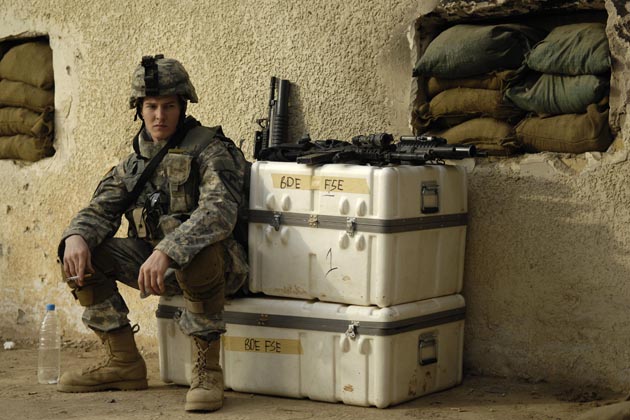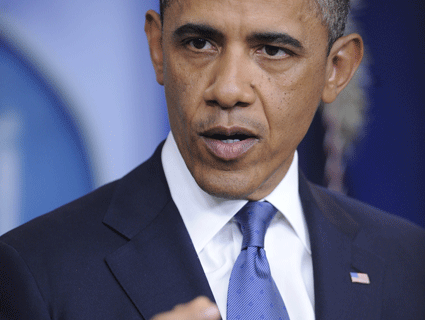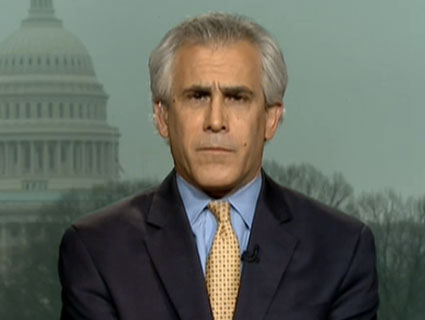
Paramedics treat multiple gunshot victims in Chicago in August 2012. Americans in violent neighborhoods are developing PTSD at rates similar to combat veterans.Devlin Brown/Chicago Tribune/ZUMA
This story originally appeared on ProPublica.
Chicago’s Cook County Hospital has one of the busiest trauma centers in the nation, treating about 2,000 patients a year for gunshots, stabbings, and other violent injuries.
So when researchers started screening patients there for post-traumatic stress disorder in 2011, they assumed they would find cases.
They just didn’t know how many: Fully 43 percent of the patients they examined—and more than half of gunshot-wound victims—had signs of PTSD.
“We knew these people were going to have PTSD symptoms,” said Kimberly Joseph, a trauma surgeon at the hospital. “We didn’t know it was going to be as extensive.”
What the work showed, Joseph said, is, “This is a much more urgent problem than you think.”
Joseph proposed spending about $200,000 a year to add staffers to screen all at-risk patients for PTSD and connect them with treatment. The taxpayer-subsidized hospital has an annual budget of roughly $450 million. But Joseph said hospital administrators turned her down and suggested she look for outside funding.
“Right now, we don’t have institutional support,” said Joseph, who is now applying for outside grants.
A hospital spokeswoman would not comment on why the hospital decided not to pay for regular screening. The hospital is part of a pilot program with other area hospitals to help “pediatrics patients identified with PTSD,” said the spokeswoman, Marisa Kollias.”The Cook County Health and Hospitals System is committed to treating all patients with high quality care.”
Right now, social workers try to identify patients with the most severe PTSD symptoms, said Carol Reese, the trauma center’s violence prevention coordinator and an Episcopal priest.
“I’m not going to tell you we have everything we need in place right now, because we don’t,” Reese said. “We have a chaplain and a social worker and a couple of social work interns trying to see 5,000 people. We’re not staffed to do it.”
A growing body of research shows that Americans with traumatic injuries develop PTSD at rates comparable to veterans of war. Just like veterans, civilians can suffer flashbacks, nightmares, paranoia, and social withdrawal. While the United States has been slow to provide adequate treatment to troops affected by post-traumatic stress, the military has made substantial progress in recent years. It now regularly screens for PTSD, works to fight the stigma associated with mental health treatment and educates military families about potential symptoms.
Few similar efforts exist for civilian trauma victims. Americans wounded in their own neighborhoods are not getting treatment for PTSD. They’re not even getting diagnosed.
Studies show that, overall, about 8 percent of Americans suffer from PTSD at some point in their lives. But the rates appear to be much higher in communities—such as poor, largely African American pockets of Detroit, Atlanta, Chicago, and Philadelphia—where high rates of violent crime have persisted despite a national decline.
Researchers in Atlanta interviewed more than 8,000 inner-city residents and found that about two-thirds said they had been violently attacked and that half knew someone who had been murdered. At least 1 in 3 of those interviewed experienced symptoms consistent with PTSD at some point in their lives—and that’s a “conservative estimate,” said Dr. Kerry Ressler, the lead investigator on the project.
“The rates of PTSD we see are as high or higher than Iraq, Afghanistan, or Vietnam veterans,” Ressler said. “We have a whole population who is traumatized.”
Post-traumatic stress can be a serious burden: It can take a toll on relationships and parenting, lead to family conflict and interfere with jobs. A national study of patients with traumatic injuries found that those who developed post-traumatic stress were less likely to have returned to work a year after their injuries.
It may also have a broader social cost. “Neglect of civilian PTSD as a public health concern may be compromising public safety,” Ressler and his coauthors concluded in a 2012 paper.
For most people, untreated PTSD will not lead to violence. But “there’s a subgroup of people who are at risk, in the wrong place, at the wrong time, of reacting in a violent way or an aggressive way, that they might not have if they had had their PTSD treated,” Ressler said.
Research on military veterans has found that the symptom of “chronic hyperarousal”—the distorted sense of always being under extreme threat—can lead to increased aggression and violent behavior.
“Very minor threats can be experienced, by what the signals in your body tell you, as, ‘You’re in acute danger,'” said Sandra Bloom, a psychiatrist and former president of the International Society for Traumatic Stress Studies.
Another issue, wrote researchers at Drexel University, is that people with symptoms of PTSD may be more likely to carry a weapon in order to “restore feelings of safety.”
Hospital trauma centers, which work on the front lines of neighborhood violence, could help address the lack of treatment. Indeed, the American College of Surgeons, which sets standards for the care of patients with traumatic injuries, is set to recommend that trauma centers “evaluate, support, and treat” patients for post-traumatic stress.
But it’s not a requirement, and few hospitals appear to be doing it.
ProPublica surveyed a top-level trauma center in each of the 22 cities with the nation’s highest homicide rates. Just one, the Spirit of Charity Trauma Center in New Orleans, currently screens all seriously injured patients for PTSD. At another, Detroit Receiving Hospital, psychologists talk with injured crime victims about PTSD.
Other hospitals have a patchwork of resources or none at all. At two hospitals, in Birmingham, Alabama and St. Louis, Missouri, trauma center staff said they hope to institute routine PTSD screening by the end of the year.
Doctors in Baltimore, Newark, Memphis, and Jackson, Mississippi, said they wanted to do more to address PTSD, but they do not have the money.
They said adding even small amounts to hospital budgets is a hard sell in a tough economic climate. That’s especially true at often-cash-strapped public hospitals.
In order to add a staff member to screen and follow up on PTSD, “Do I lay someone else off in another area?” asked Carnell Cooper, a trauma surgeon at Maryland Shock Trauma in Baltimore.
Many public hospitals rely on state Medicaid programs to cover treatment of low-income patients. But several surgeons across the country said they did not know of any way they could bill Medicaid for screenings.
The federal government often provides guidance to state Medicaid programs on best practices for patient care and how to fund them. But a spokeswoman for the Centers for Medicare and Medicaid Services said the agency has given states no guidance on whether or how hospitals could be reimbursed for PTSD screenings.
Hospitals are often unwilling to foot the bill themselves.
Trauma surgeons and their staffs expressed frustration that they know PTSD is having a serious impact on their patients, but they can’t find a way to pay for the help they need.
“We don’t recognize that people have PTSD. We don’t recognize that they’re not doing their job as well, that they’re not doing as well in school, that they’re getting irritable at home with their families,” said John Porter, a trauma surgeon in Jackson, which has a per capita homicide rate higher than Chicago’s.
“When you think about it, if someone gets shot, and I save their life, and they can’t go out and function, did I technically save their life? Probably not.”
When RAND Corp. researchers began interviewing violently injured young men in Los Angeles in the late 1990s, they faced some skepticism that the men, often connected to gangs, would be susceptible to PTSD.
“We had people tell us that we’d see a lot of people who were gang-bangers, and they wouldn’t develop PTSD, because they were already hardened to that kind of life,” said Grant Marshall, a behavioral scientist who studied patients at a Los Angeles trauma center. “We didn’t find that to be the case at all. People in gangs were just as likely as anyone else to develop PTSD.”
In fact, trauma appears to have a cumulative effect. Young men with violent injuries may be more likely to develop symptoms if they have been attacked before.
The Los Angeles study found that 27 percent of the men interviewed three months after they were injured had symptoms consistent with PTSD.
“Most people still think that all the people who get shot were doing something they didn’t need to be doing,” said Porter, the trauma surgeon from Jackson. “I’m not saying it’s the racist thing, but everybody thinks it’s a young black men’s disease: They get shot, they’re out selling drugs. We’re not going to spend more time on them.”
While post-traumatic stress often does not show up until several months after an injury, experts say many trauma centers are missing the chance to evaluate patients early for risk of PTSD and to use clinical follow-ups—when patients come back to have their physical wounds examined—to check if patients are developing symptoms.
Doctors say hospitals are unlikely to make significant progress until the American College of Surgeons makes systematic PTSD screening a requirement for all top-level trauma centers.
An ACS requirement would be “a much better hammer to show the administration,” said Michael Foreman, chief of trauma surgery at Baylor University Medical Center in Dallas. Baylor, one of the few trauma centers to have a full-time psychologist on staff, surveyed 200 patients and found that roughly a quarter experienced post-traumatic stress. But Foreman said the center would not systematically screen all its patients until the ACS mandates it.
It’s not clear when that will happen. The organization’s recognition of PTSD screening as a recommended practice is a first step. Those new guidelines will be released in March 2014, according to Chris Cribari, who chairs the subcommittee that evaluates whether hospitals are meeting ACS standards. Cribari declined to say when PTSD screening might become a requirement. He said the timing will depend on what hurdles hospitals encounter—such as patient privacy—when some of them start screenings.
Cribari acknowledged that at some hospitals, “unless it’s a regulation, they’re not going to spend the money on it.”
At minimum, experts say, hospitals should provide all trauma patients with basic education about post-traumatic stress.
“The number one thing we do,” is simply “tell everybody in the trauma center about PTSD,” said John Nanney, a Department of Veterans Affairs researcher who developed a program for violently injured patients at the Spirit of Charity in New Orleans.
Without education about symptoms, patients who have flashbacks or constant nightmares may have “these catastrophic beliefs” about what is happening to them, Nanney said. “Just say, ‘This is something you might notice. If you do notice it, it doesn’t mean you’re going crazy. It doesn’t mean you’re weak. This is something that happens—don’t freak out.'”
The city of Philadelphia has begun to focus on trauma as a major public health issue. Philadelphia is working with local mental health providers to screen for PTSD more systematically—and to focus on post-traumatic stress as part of drug and alcohol treatment. The city has also paid to train local therapists in prolonged exposure, a proven treatment for PTSD—the same kind of training the US Department of Veterans Affairs has paid for its therapists to receive.
For violently injured Philadelphia residents, there’s also Drexel University’s Healing Hurt People, a program that’s become a national model for addressing trauma and PTSD.
Healing Hurt People reaches out to violently injured adults and children at two local hospitals and offers them intensive services. The program accepts a broad range of patients—from high-schoolers to siblings of young men who have been shot to former drug dealers. (One of Healing Hurt People’s clients talked about his post-traumatic stress in 2013 on This American Life.)
The program’s social workers screen all clients for PTSD symptoms and host discussions in which clients can share their experiences with one another. It’s a way of fighting stigma around mental-health symptoms. Instead of thinking that they’re going crazy, the conversations help them realize, “Okay, this is normal,” as one client put it.
One of the program’s central goals is to discourage victims of crimes from retaliating against their attackers and to help them focus on staying safe and rebuilding their own lives.
The program’s therapists and social workers remind clients that the aftereffects of trauma may make them overreact and help them plan how to identify and avoid events that might trigger them. In one discussion last fall, a therapist sketched a cliff on a whiteboard, with a stick man on the top, close to the edge. The question: How do you recognize when you’re getting close to the cliff edge—and learn to walk away?
“Our thing is education,” social worker Tony Thompson said. The more clients “understand what’s going on in their body and their mind, the more prepared they are to deal with it.”
Intensive casework like this has shown good results, but it’s not cheap. Healing Hurt People is relatively small: Its programs served 129 new clients in 2013 and offered briefer education or assistance to a few hundred more. Its annual budget in 2013 was roughly $300,000, not including the cost of the office space that Drexel donates to the program.
Other researchers have been working to develop quicker, more modest interventions for PTSD, including some that use laptops and smartphones—programs that could easily be extended to more patients and still have some positive effect.
Whatever the approach, there “is untapped potential,” said Joseph, the surgeon at Chicago’s Cook County Hospital. Healing Hurt People is a model for what she wants to create. “These are kids, for the most part. When a 17-year-old kid crashes their parents’ car, and they were drinking, we don’t say, ‘Oh, that kid’s hopeless, let’s just give up on them.'”
“We’ve certainly had decades of trying to apply political solutions and social solutions to our inner cities’ financial problems and violence problem, and they haven’t been successful,” said Ressler, the Atlanta researcher. “If we could do a better job of identification, intervention and treatment, I think there would be less violence, and people would have an easier time doing well in school, getting a job.”
















